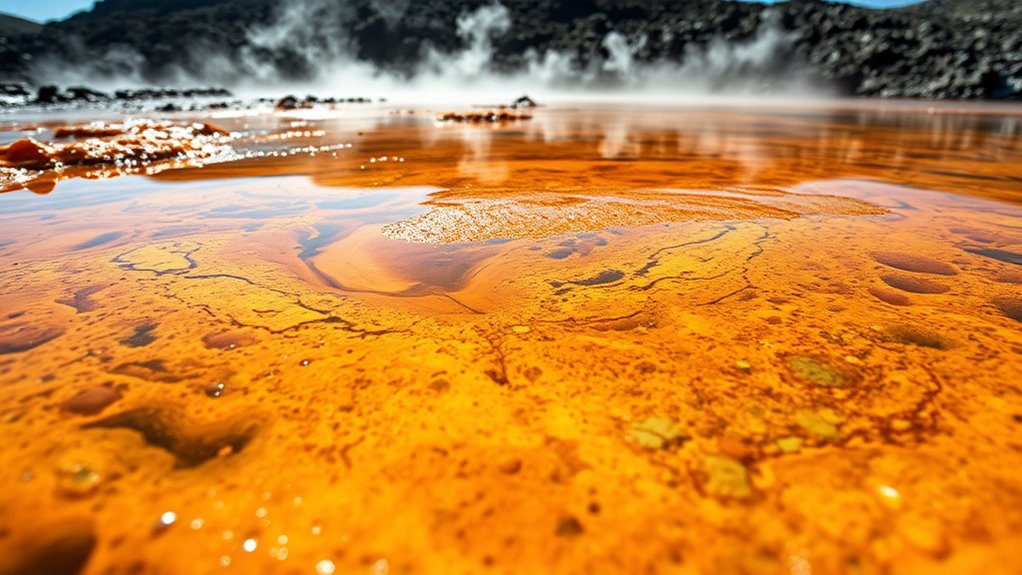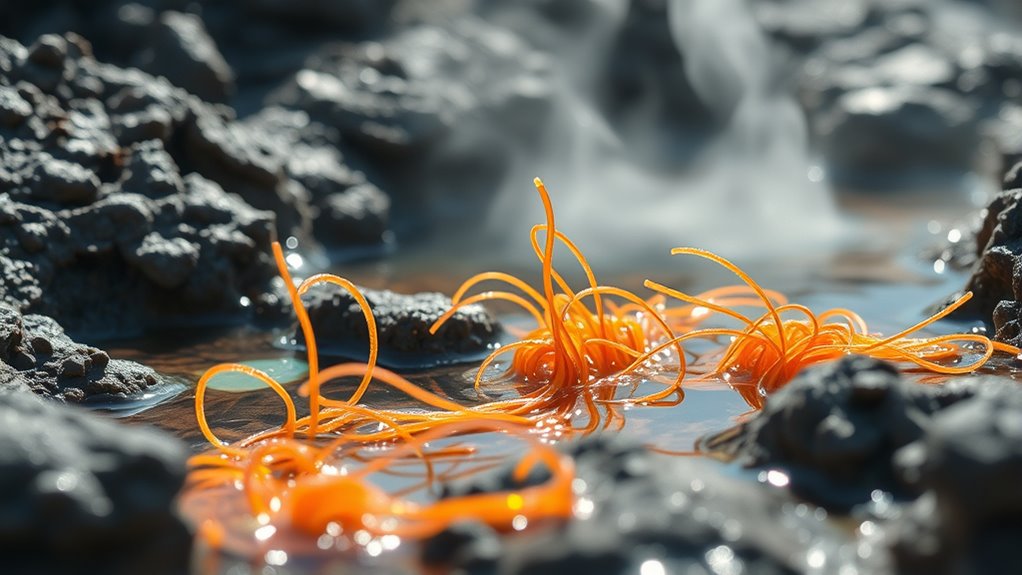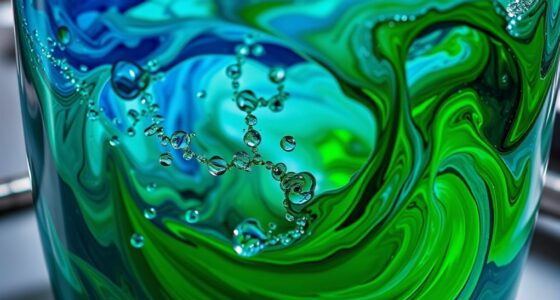Extremophiles are life forms that thrive in Earth’s harshest environments, from scalding hot springs to icy tundras. They’ve developed unique biochemical adaptations, allowing them to withstand extreme heat, cold, acidity, and salinity. For instance, thermophiles use specialized proteins to resist heat, while halophiles manage osmotic pressure in salty ecosystems. Each type of extremophile showcases nature’s resilience and adaptability. Discovering their secrets reveals the incredible possibilities of life in conditions many consider uninhabitable.
Key Takeaways
- Extremophiles thrive in extreme environments, showcasing life’s resilience in conditions like high heat, salinity, cold, and pH extremes.
- Thermophiles possess specialized proteins that maintain their structure and function at temperatures exceeding 200°F, enabling industrial enzyme applications.
- Halophiles adapt to high-salinity environments by accumulating compatible solutes to stabilize cellular processes against osmotic pressure.
- Psychrophiles have enzymes that function efficiently at low temperatures, allowing them to metabolize and sustain life in freezing conditions.
- Acidophiles and alkaliphiles exhibit biochemical adaptations that enable survival in corrosive environments with extreme pH levels, showcasing their versatility.

Have you ever wondered how life thrives in the harshest environments on Earth? You might think that extreme conditions like boiling hot springs, icy tundras, or acidic lakes would be devoid of life, but you’d be wrong. In fact, extremophiles—organisms that flourish in such environments—have developed unique biochemical adaptations and survival mechanisms that allow them to not just survive, but thrive where most life forms would perish.
Take thermophiles, for example. These heat-loving bacteria can withstand temperatures exceeding 200 degrees Fahrenheit. Their secret lies in specialized proteins that don’t denature under such extreme heat. These proteins maintain their structure and function, allowing the organisms to carry out essential processes like metabolism and reproduction. You can see this in action when you look at the enzymes produced by thermophiles, which scientists often use in industrial applications because they can function effectively even at high temperatures.
Thermophiles thrive in extreme heat, utilizing specialized proteins to power vital processes and inspire industrial innovations.
Then, there are halophiles, organisms that thrive in salt-rich environments like salt flats or salt mines. You might think the high salinity would be detrimental, but these extremophiles have evolved survival mechanisms that actually help them manage osmotic pressure. They accumulate compatible solutes—small organic molecules that stabilize their cellular processes—allowing them to maintain cellular integrity despite the harsh conditions. It’s fascinating how nature finds a way to adapt, isn’t it?
Next, consider psychrophiles, those hardy organisms that thrive in frigid temperatures. They possess enzymes that remain active at low temperatures, allowing them to metabolize and grow where other life forms freeze. Their lipid membranes are also adapted to stay fluid in cold conditions, enabling them to maintain cellular functions. You’ve got to admire how these organisms have managed to carve out their niche in such extreme environments.
Even in acidic or alkaline waters, life finds a way. Acidophiles and alkaliphiles are examples of extremophiles that have biochemical adaptations enabling them to thrive in environments with pH levels that would be lethal to most organisms. Their cellular machinery is specially adapted to handle the corrosive nature of their surroundings, illustrating that life is incredibly resilient. Unique high-quality products in home decor and gifts can inspire us to appreciate the wonders of nature and its incredible diversity.
In essence, extremophiles reveal the incredible adaptability of life. By studying these organisms, you not only gain insight into the limits of life on Earth but also uncover potential applications for biotechnology and medicine. So, the next time you think of life, remember that it can exist in the most unexpected places, driven by remarkable biochemical adaptations and survival mechanisms.
Frequently Asked Questions
How Do Extremophiles Contribute to Biotechnology Advancements?
Extremophiles play a vital role in biotechnology advancements by providing unique enzymes that withstand extreme conditions. You can harness these enzymes in enzyme engineering to develop more efficient processes for various industries. Additionally, extremophiles are key in bioremediation techniques, helping to break down pollutants and restore contaminated environments. Their resilience allows scientists to create innovative solutions that traditional organisms can’t, pushing the boundaries of what’s possible in biotechnology.
Can Extremophiles Survive in Space Environments?
Yes, extremophiles can survive in space environments! Their incredible resilience allows them to endure the harsh conditions of outer space, including radiation and extreme temperatures. You’ll find that some microorganisms have even shown signs of extraterrestrial adaptation, thriving in vacuum-like conditions. These unique traits help scientists explore the possibilities of life beyond Earth and could inform future space missions. Just imagine what else we might discover about life in the cosmos!
What Role Do Extremophiles Play in Climate Change?
Extremophiles play a vital role in climate change by participating in climate regulation and carbon cycling. You’ll find these organisms thriving in extreme conditions, where they help decompose organic matter and release carbon back into the atmosphere. Their unique adaptations allow them to influence greenhouse gas levels, impacting overall climate dynamics. By understanding their functions, you can better appreciate how these tiny life forms contribute to Earth’s complex ecological balance amidst changing climates.
Are There Extremophiles That Can Be Harmful to Humans?
Yes, there are pathogenic extremophiles that can be harmful to humans. Some extremophiles produce toxins that can lead to serious health issues. For example, certain halophiles, which thrive in high-salt environments, can produce extremophile toxins that affect your immune system. These microbes often inhabit extreme environments but, when introduced to human populations, can pose significant risks. It’s essential to understand their potential dangers, especially in industrial or contaminated settings.
How Are Extremophiles Studied in Laboratory Settings?
In a lab, you might witness extremophiles thriving in harsh conditions, resembling tiny survivors in a world of chaos. To study them, researchers use laboratory cultivation techniques to replicate extreme environments, ensuring these organisms flourish. They then plunge into genetic analysis, decoding their unique DNA to understand resilient traits. This research not only uncovers the mysteries of life but also paves the way for breakthroughs in medicine and biotechnology.
Conclusion
As you explore the secrets of extremophiles, imagine a tiny, resilient creature thriving in a boiling hot spring, much like a fearless adventurer conquering the fiercest mountains. These remarkable organisms, with their ability to adapt to extreme conditions, remind us that life can flourish in the most unexpected places. Just as they push the boundaries of existence, so can you—embracing challenges and uncovering the hidden wonders within your own journey. Life’s extremes can lead to extraordinary discoveries.










